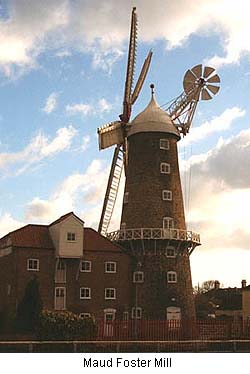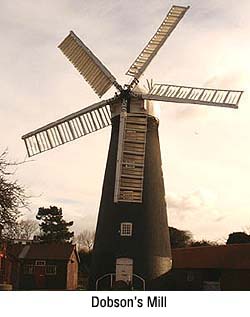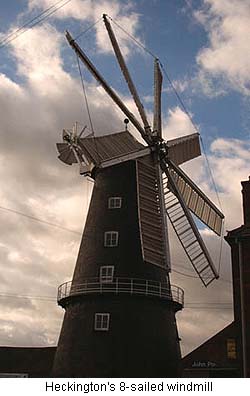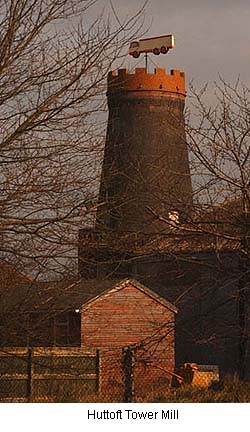Winds of Change: Lincolnshire's Historic Windmills
by Mary Cook
 Historic Lincolnshire is a beguiling mix of
rolling hills (The Wolds) and fenland, scattered with old towns
and villages, and defined on its eastern side by miles of golden
sands bordering the North Sea. Historic Lincolnshire is a beguiling mix of
rolling hills (The Wolds) and fenland, scattered with old towns
and villages, and defined on its eastern side by miles of golden
sands bordering the North Sea.
Around 800 windmills were grinding flour for Lincolnshire's
inhabitants up to a century ago. But winds of change have blown
across the county, leaving some mills in ruins while giving
others a new lease of life. Local government organizations,
charitable trusts and private enterprise have been working to
convert them into tourist attractions.
Making Boston your touring base -- "the original Boston", as
locals are proud to tell overseas visitors -- you'll find some
attractive mills within easy reach. Founded in the seventh
century, Boston is a thriving market town, rich in history, with
strong associations with the Pilgrim Fathers. (For more
information on Boston, see Boston of the Fenlands and Its Stump).
The Maud Foster Mill
You can walk from Boston town centre to the Maud Foster Mill.
Built in 1819 and open to the public on designated days
throughout the year, this privately owned windmill is
Lincolnshire's tallest working mill. You can climb seven floors
and watch the mechanism in action.
A shop sells organic flour ground on the premises, as well as
souvenirs. And there's a tea room where you can sample local
delicacies.
Sibsey Trader Mill
Trader Mill at Sibsey, five miles north of Boston, was built
in 1877 by Saundersons of Louth. This fine example of a
six-sailed working windmill is open to the public on designated
days throughout the year. Like several other mills in the area,
it has a tea shop and souvenirs for sale.
Alford Five-Sailed Windmill
 If you follow the A16 road from Boston, you'll be
heading for the market town of Alford. At one time Alford had
four mills with four, five and six sails apiece. One was last
seen reduced to a single story and living out its retirement as a
garden shed. If you peek over hedges and fences about the town
you're likely to see millstones used as garden ornaments. If you follow the A16 road from Boston, you'll be
heading for the market town of Alford. At one time Alford had
four mills with four, five and six sails apiece. One was last
seen reduced to a single story and living out its retirement as a
garden shed. If you peek over hedges and fences about the town
you're likely to see millstones used as garden ornaments.
Today the town, whose market charter dates back to the 13th
century, still has its five-sailed mill, known as the Hoyles Mill. Built in 1837 by local millwright John Oxley, it was operated commercially by the Hoyles
family until it stopped working in 1955.
It was later bought by Fred Banks who restored it to working
order. In 1978 he replaced the sails. That same year the mill was
taken over by a local government authority who leased back to
him. There have been two other leaseholders since.
The mill opens year round on designated days. In its tea room you
can take a bite out of history with scones made from flour ground
on the premises. And the engine house has been turned into an
antiques centre.
Huttoft Tower Mill
The coastal village of Huttoft, where the prevailing wind
blows off the sea, is about four miles from Alford on the A52
road.
Proving you can have too much wind, Huttoft's four-sailed
windmill lost its sails in a storm of 1945 after about a century
of milling. The building is now used by an animal feed merchant
as a grain store. Its most distinctive features are the
comparatively modern truck logo on the top and the original
wrought iron staging which suggests the same firm that built
Sibsey Trader Mill had a hand in this one.
Wainfleet
Bateman's Brewery has taken over a 200-year-old windmill in
the picturesque town of Wainfleet, near Skegness, to produce ales
brewed in the traditional way. You can't miss its giant beer
bottle weather vane. The mill -- ivy-covered, but minus sails --
has a visitor center offering guided tours. Attractions include
the biggest collection of beer bottles in the country. The base
of the windmill is set out as a traditional English pub where you
can raise a glass to this key aspect of England's heritage.
Burgh-le-Marsh Windmill
 Local author Margaret Dickinson set her novel The Miller's
Daughter here. Thoroughly researched, her book gives a true
insight into the life of a Lincolnshire miller.
Local author Margaret Dickinson set her novel The Miller's
Daughter here. Thoroughly researched, her book gives a true
insight into the life of a Lincolnshire miller.
Rejoice all you left-handed people -- Dobson's Mill is
left-handed! The only one in the county to turn clockwise, it's
open to the public most Sundays. From a static display you can
learn about the history of milling as well as buying souvenirs
from the gift shop
Heckington Windmill
>One of Lincolnshire's most beautiful landmarks, Heckington
Windmill is England's sole surviving eight-sailed mill. Visible
from the A17 road, close to Sleaford, it was built in 1830 by
Edward Ingledew, of Gainsborough, It originally had five sails.
It fell into disrepair in the latter part of the 19th century and
was nearly destroyed by a storm in 1890.
Boston miller John Pocklington resurrected it by replacing the
sails with an eight-sailed arrangement he salvaged from another
mill that was being demolished. Having refitted the mill he
operated it until his death in 1941.The mill has since been
rescued from dereliction by a local government authority with
help from volunteer conservationists. It has a ground floor shop
selling souvenirs, books and flour products.You can read about
its history on Lincolnshire's windmill page.
Although windmills are thin on the ground today, wind power is
making a comeback in Lincolnshire with clusters of wind turbines
springing up along the coast. Now "windmills" produce electricity
where they once produced flour. As they say, what goes around
comes around.
Related Articles:
- Boston of the Fenlands and Its Stump, by Lisa Agnew
- https://www.timetravel-britain.com/articles/towns/boston.shtml

More Information:
More Information:
We regret that we no longer have the resources to maintain up-to-date links and/or hours and pricing details for the various sites and attractions listed on this website. For more information about the location(s) listed above, please use your favorite search engine or visit Wikipedia.
Mary Cook has been freelancing for nearly 17 years, and
has published numerous articles, short stories and poems in print
and online publications. Her primary interests are humor,
self-sufficient living, and the craft and business of writing.
She lives in the county of Lincolnshire, "arguably one of
the most beautiful and historic areas in the UK," and was a
reporter for a regional paper for more than five years, during
which time she provided most of the editorial content for the
paper's annual tourist guides.
Article and photos © 2008 Mary Cook
| 